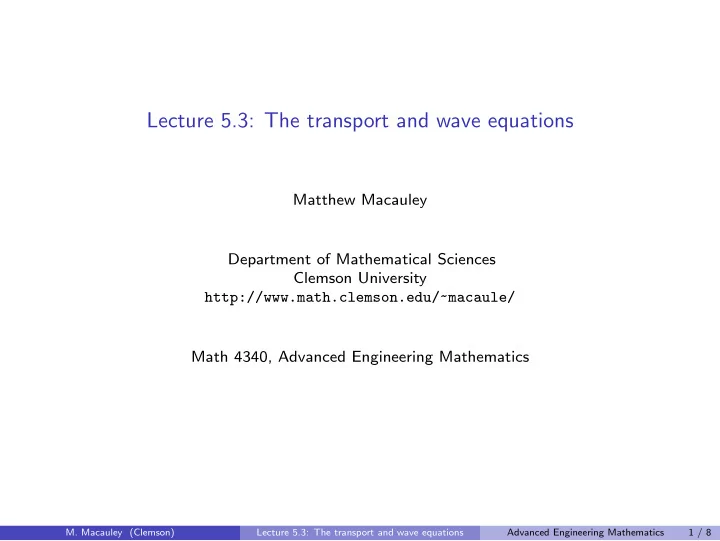

Lecture 5.3: The transport and wave equations Matthew Macauley Department of Mathematical Sciences Clemson University http://www.math.clemson.edu/~macaule/ Math 4340, Advanced Engineering Mathematics M. Macauley (Clemson) Lecture 5.3: The transport and wave equations Advanced Engineering Mathematics 1 / 8
Motivation Some common one-dimensional PDEs We’ve seen the heat equation: u t = c 2 u xx . In this lecture, we will introduce the transport equation, from which we will derive the wave equation: u tt = c 2 u xx . M. Macauley (Clemson) Lecture 5.3: The transport and wave equations Advanced Engineering Mathematics 2 / 8
Transport left Example 1 Consider the following PDE involving a function u ( x , t ): ∂ u ∂ t − c ∂ u ∂ x = 0 . M. Macauley (Clemson) Lecture 5.3: The transport and wave equations Advanced Engineering Mathematics 3 / 8
Transport right Example 2 Consider the following PDE involving a function u ( x , t ): ∂ u ∂ t + c ∂ u ∂ x = 0 . M. Macauley (Clemson) Lecture 5.3: The transport and wave equations Advanced Engineering Mathematics 4 / 8
The wave equation Example 3 Consider the following PDE involving a function u ( x , t ): � ∂ �� ∂ u = ∂ 2 u ∂ t 2 − c 2 ∂ 2 u ∂ t + c ∂ ∂ t − c ∂ � ∂ x 2 = 0 ∂ x ∂ x M. Macauley (Clemson) Lecture 5.3: The transport and wave equations Advanced Engineering Mathematics 5 / 8
The three most common two-variable PDEs Summary Let u ( x , t ) be a function of position x and time t . Then the heat equation is u t = c 2 u xx , the wave equation is u tt = c 2 u xx . One more Let u ( x , y ) be a function of position ( x , y ). Then Laplace’s equation is u xx + u yy = 0. M. Macauley (Clemson) Lecture 5.3: The transport and wave equations Advanced Engineering Mathematics 6 / 8
Example 3 Solve the following B/IVP for the wave equation: u tt = c 2 u xx , u (0 , t ) = u ( L , t ) = 0 , u ( x , 0) = x ( L − x ) , u t ( x , 0) = 1 . M. Macauley (Clemson) Lecture 5.3: The transport and wave equations Advanced Engineering Mathematics 7 / 8
Example 3 (cont.) The general solution to the following BVP for the wave equation: u tt = c 2 u xx , u (0 , t ) = u ( L , t ) = 0 , u ( x , 0) = x ( L − x ) , u t ( x , 0) = 1 . ∞ � �� � � cn π t � � cn π t � n π x � is u ( x , t ) = a n cos + b n sin sin . Now, we’ll solve the remaining IVP. L L L n =1 M. Macauley (Clemson) Lecture 5.3: The transport and wave equations Advanced Engineering Mathematics 8 / 8
Recommend
More recommend